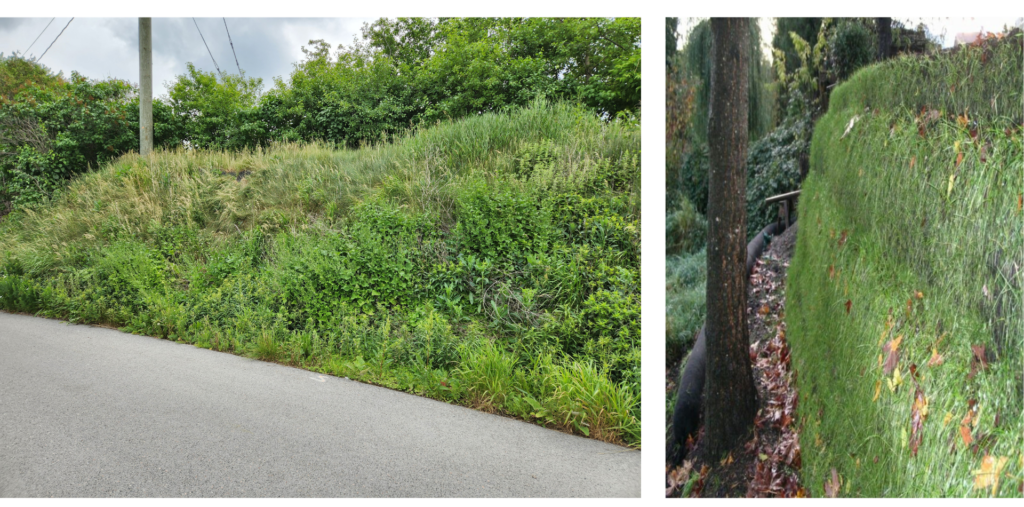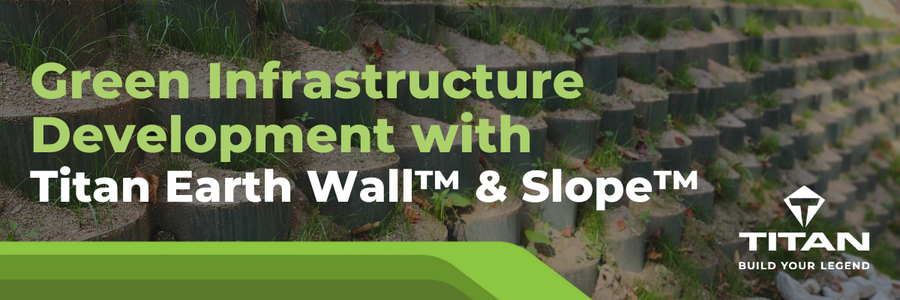Mechanically stabilized earth (MSE) walls and slopes are earthen structures made from layers of compacted aggregate backfill and geosynthetic reinforcements. Considering all the advantages of these systems, it makes sense that they’ve become a top choice among engineers.
Compared to concrete structures, MSE systems tolerate greater differential settlement, allowing for a superior foundation. In addition to their high durability, MSE walls and slopes are simple to install, economically beneficial, and feature a significant range of face and backfill material options. They can also be custom designed to suit the needs and location of almost any project. Benefits such as these have made them very useful for both permanent and temporary applications.
The Greener Choice
One of the greatest advantages of MSE walls and slopes is they’re designed to mitigate negative environmental impacts, making them an excellent example of Low Impact Development (LID).
In a study published by the Journal of Cleaner Production, MSE walls were found to be the most sustainable retaining wall option when compared with Plain Concrete Gravity walls, Reinforced Concrete Cantilever walls, Masonry Brick walls, and Gabion Limestone Cage walls. The efficiency of MSE walls over conventional walls was found to increase with the height of the wall itself. Overall, constructing MSE walls instead of conventional walls contributes to 10 of the 17 United Nations (UN) Sustainable Development Goals (SDGs).¹
MSE structures effectively prevent erosion by stabilizing soil and stopping sediment from washing into waterways. This:
- Promotes groundwater recharge
- Protects local wildlife and vegetation
- Maintains soil quality
- Reduces flood risk
- Safeguards water resources for peoples’ needs
MSE Systems are designed with lightweight materials that can be easily hand-placed, eliminating the need for heavy-duty equipment and reducing the freight of shipping materials. Together, these factors contribute to a significantly lower carbon footprint for your project, making MSE Systems an environmentally friendly choice.
Thanks to their superior durability, MSE structures have a design life of 75 to 100 years and require less maintenance, reducing construction-related impacts over time.
There’s also an opportunity to make your system an even greater example of Green Infrastructure by tailoring its materials. Take a look below to see some of our most sustainable options.
Vegetated Systems
We’re proud to provide greater sustainability with all our solutions. For MSE walls and slopes, our vegetative systems offer aesthetically pleasing faces that benefit the local environment and are suitable for LEED standards.

Titan Earth Wall™- Living
In both walls and slopes, we offer a Living system that’s perfect for projects requiring a soft face and high sustainability. By filling the silt sock facing unit with a growth median, we can choose a seed mix that will integrate with the surrounding vegetation. Adding the seed mix is a simple process, as it can be incorporated within the organic compost median or hydro-seeded once construction is complete.
Living vegetation doesn’t just look great. It also helps reduce the project’s carbon footprint over time, as plants play a crucial role in absorbing CO2. This natural process helps mitigate environmental impact by promoting green spaces, enhancing biodiversity, and protecting local habitats. In addition, the Erosion Control Technology Council (ECTC), a reputable non-profit organization, confirms that vegetated systems can act as a water filtration system, pollinator corridors, and may allow cooler runoff to divert to nearby bodies of water.²
For projects up to a 70º batter, we also offer a Titan Earth Slope™ Veggie system.
This innovative solution uses a vegetated wire face consisting of a welded wire form with a UV-stabilized biaxial geogrid and erosion control blanket wrap, which provides lasting durability and nurtures vegetation growth. In addition to their natural appearance, they’re lightweight, easy to construct, and accommodating to the land’s curves.
Sources referenced in this article:
¹ Morsy, Karim M. “Comparative Evaluation of the Environmental Impacts of Geosynthetic Mechanically Stabilized Earth Walls.” Edited by Hoda Thakeb, Journal of Cleaner Production, 10 Nov. 2022, doi.org/10.1016/j.jclepro.2022.133912
² ECTC News. “Green MSE Walls and Erosion and Sediment Control Applications.” Geosynthetics Magazine, 1 Oct. 2022, geosyntheticsmagazine.com/2022/10/01/green-mse-walls-and-erosion-and-sediment-control-applications/
Committed to Helping You
Sustainable infrastructure plays a pivotal role in shaping a resilient future. By prioritizing environmentally conscious practices and materials, infrastructure projects can minimize their ecological footprint while maximizing long-term benefits for communities and ecosystems alike.
At Titan, we’re dedicated to delivering sustainable, durable and economical solutions that meet your project needs. Our team of experts will always be ready to identify which MSE system is right for your project and can provide on-site support through the installation process.
By working together, you can complete your project on time and within budget while reducing environmental impacts along the way. Choose us and we’ll be your partner in building a better way forward.

